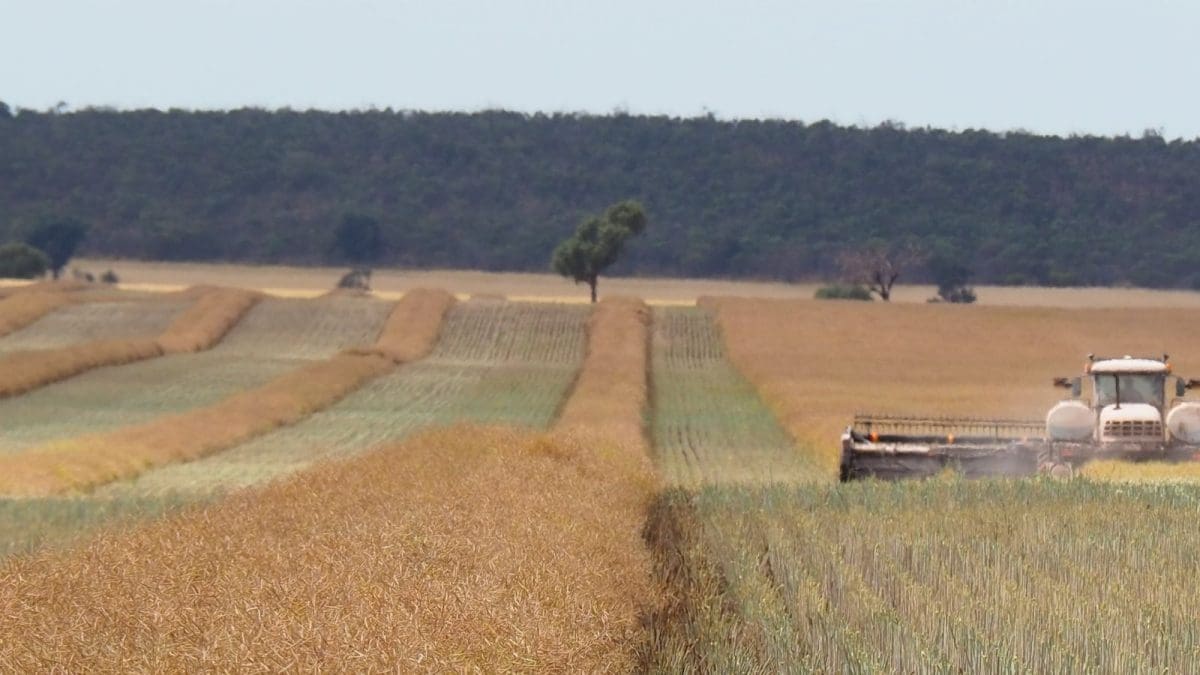
Windrowing canola near Hillston in south-west NSW. Photo: Richard West, Pioneer Seeds
AUSTRALIA is on track to produce a canola crop of 3.34 million tonnes (Mt), according to the October crop report from the Australian Oilseeds Federation (AOF).
“A return towards La Niña conditions has had the expected results, with generally wetter-than-average conditions on the east coast and drier-than-average conditions on the west coast,” AOF executive officer Nick Goddard said.
“This has significantly improved crop prospects for NSW, with canola sown from border to border, north to south.
NSW and Victoria are forecast to produce 50 per cent more than the five-year average, and 26pc above the 10-year average, so domestic crushers will have ample supplies, with up to 800,000 tonnes potentially available for export.
The drier conditions in WA will deliver a crop down 20-25pc on the medium-long term average.
“Overall production has also been bolstered by an increase in area sown to canola as many growers switched out of barley once the Chinese tariff situation became apparent.
“The early and mid-season decile rainfall maps demonstrate the impact of La Niña conditions, highlighting the difference between east and west coast rainfall.”
The AOF tonnage forecast for 3.34Mt is slightly under the ABARES estimate released in its September Australian Crop Report of 3.42Mt.
On area, ABARES’ estimates is for 2.378M hectares, 103,000t above the AOF estimate.
| 2019-20 |
2020-21 October estimate | |||
| Harvested hectares | Tonnes | Hectares | Tonnes | |
| NSW | 160,000 | 176,000 | 500,000 | 900,000 |
| VIC | 385,000 | 699,000 | 450,000 | 855,000 |
| SA | 220,000 | 324,000 | 225,000 | 370,000 |
| WA | 923,000 | 1,117,000 | 1,100,000 | 1,215,000 |
| TOTAL | 1,688,000 | 2,316,000 | 2,275,000 | 3,340,000 |
Source: Industry estimates from Grain Industry Association of WA, the Department of Primary Industries and Resources SA and the NSW Department of Primary Industries.
New South Wales
The late summer and early season rainfall in NSW encouraged earlier planting this year, providing good establishment early in the season. The trend towards grazing canola also continued, and was further encouraged by the early favourable conditions.
The projected state average yield of 1.8t/ha is the best for NSW since the 2012-13 season, bolstered by yields of 2-3t/ha in the Macquarie Valley, southern Riverina and south-west slopes.
Favourable conditions have encouraged growers to be generous with nitrogen applications which will certainly boost yield, but may pull back oil content in favour of protein.
Crop development is generally ahead of where one would expect by this time due to both the tendency to early sow, and the above-average winter temperatures.
Windrowing has started in northern NSW west of the Newell Highway.
Crops have been managed well for pests and diseases, as the expected higher yield has justified relatively widespread use of sprays.
The impact of October storms and heavy rain throughout much of the state is yet to be seen, but some crops already windrowed are too wet to harvest and seeds may sprout before drying out.
Heavy rain and storms across NSW may have taken some of the gloss of its production estimate.
Elsewhere, in a number of cases, harvest will be delayed as paddocks are too wet for machinery.
Victoria
The Victorian canola crop has continued to do well, with good soil moisture able to comfortably carry the crops through the drier mid season. As with NSW, many growers took advantage of soil moisture levels pre-season and elected to plant early.
Rain early last month came at the right time to replenish soil moisture and aid pod fill.
The Wimmera and southern districts have been spared the heavy rain and storms that hit NSW, while the Mallee has had good rain, and there could still be some upside in the Victorian yield estimate of 1.9t/ha.
Agronomy management, disease incidence, fungicide programs and pest pressure all very similar to NSW.
South Australia
A dry August in some districts has tended to put a cap on yield potential, but elsewhere, the rain early last month came at the right time to help with pod fill.
Windrowing has started in South Australia’s lower-rainfall areas.
Pest pressure has been generally low throughout the season, including low incidence of diamondback moth.
Western Australia
Western Australia had a very late seasonal break and a generally poorer season with rainfall at or below decile 5 in most areas and as low as decile 2-3 in many areas.
Some decent rain in early August has driven some better crops in south and south west regions, and some crops along the Albany Highway line are projected to yield 2t/ha, double the state average.
Generally speaking, WA crops are finishing on limited or no moisture, which will impact oil content.
Domestic WA demand for seed for both crushing and as wholeseed for poultry is now close to 100,000t, leaving around 1.1Mt for export this year.
Source: AOF



HAVE YOUR SAY